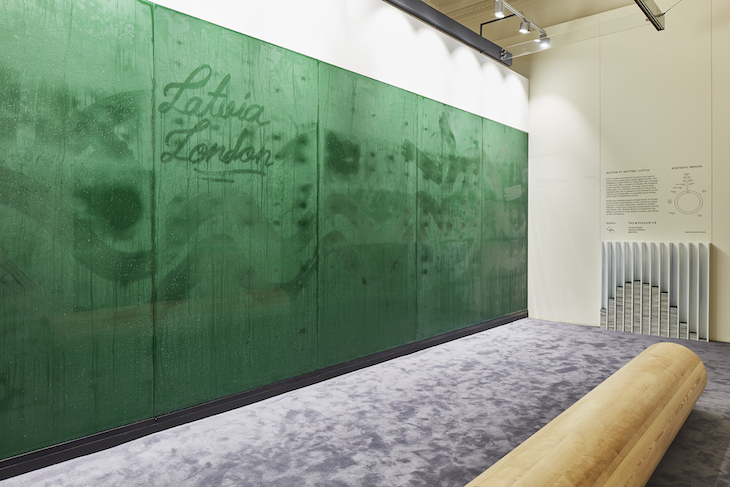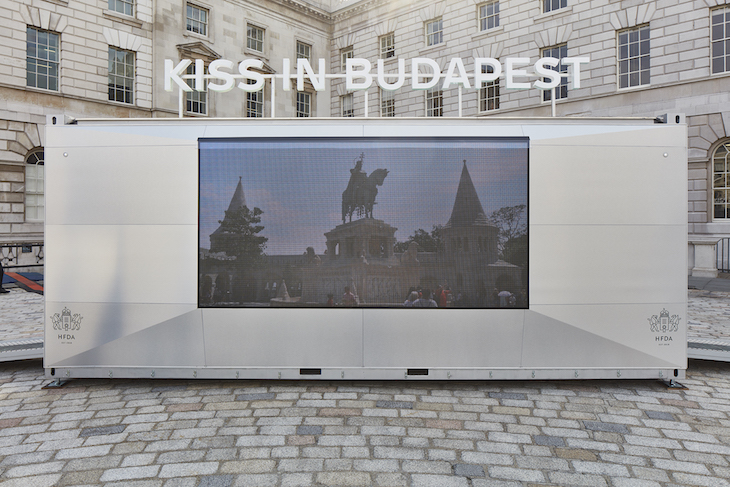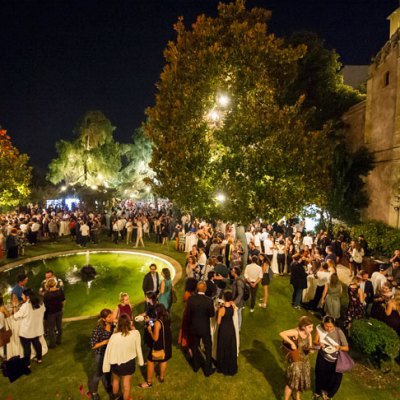When Arthur Analts’ brother visited London he traced a smiley face through the condensation on Analts’ kitchen window. ‘After he’d gone back to Latvia, I got up to make breakfast and noticed the smiley face on the glass. I thought it was amazing that he was now in a different city but also still here, with me – in the kitchen,’ the Latvian-born industrial designer recalls.
The condensation inspired Analts to create a surface where messages would be fleeting. The result is a panel, more than two metres high, made of green glass to evoke Latvia’s forests, where rivulets of water gradually erase words left by visitors. Matter to Matter joins submissions from 40 countries and cities in this year’s London Design Biennale at Somerset House, all exploring one idea: ‘Emotional States’.
Installation view of Matter to Matter by Arthur Analts (Latvia) at the London Design Biennale. Photo: Ed Reeve

The theme feels appropriate at a moment when politics are fractious and emotionally charged. A vacuum of hard knowledge has been ‘filled by rumours, fantasy and guesswork’, writes Will Davies in his recent book Nervous States: How Feeling Took Over the World. ‘Some feelings have greater political potency than others. Feelings of nostalgia, resentment, anger and fear have disrupted the status quo,’ he adds.
Sir John Sorrell, president of the biennale, compares the event to the World Cup or Olympics – events whose global scope make them innately political. The inaugural biennale in 2016 was curated around the theme of ‘Utopia’. This year’s directive was to ‘investigate the important relationship between design, strong emotional responses and real social needs’. Analts’ piece won best design medal for its interpretation: the dripping microclimate is ‘reliant on advanced technology but also critiques the marks that these human interventions leave on nature’, Analts says.
Installation view of The State of You by Aisha Nasser Al-Sowaidi (Qatar) at the London Design Biennale. Photo: Ed Reeve

Designers’ responses extend beyond space to the use of smell and touch, making for a show that can be delightfully sensuous. A room of scratch-and-sniff wallpaper recalls the egg tarts and roasted duck found in Hong Kong, whose name translates as ‘fragrant harbour’. An installation about cashmere production in Mongolia invites visitors to fondle a woolen cloud. A series of suspended domes emit scented smoke that recall designer Aisha Nasser Al-Sowaidi’s nostalgia for Doha, Qatar’s fast-changing capital. Less appealing is the scent of Switzerland’s submission, a vast petri dish containing bacteria from the room in which it sits.
Installation view of Disobedience by Nassia Inglessis (Greece) at the London Design Biennale. Photo: Ed Reeve

The most memorable installation comes from Greece. Disobedience is a 17-metre long corridor that sits in Somerset House’s stately stone courtyard. Its interlinked skin of recycled plastic contracts and flexes with visitors’ movements, opening into a whalebone arch as they step inside. Taking inspiration from Greek myth and disobedient characters such as Prometheus and Antigone, designer Nassia Inglessis’ piece invites people to negotiate a passageway that feels like walking on water.
Other installations take aim at the erasure of cultural identities and histories. The UK’s entry from Forensic Architecture reveals the group’s ongoing collaboration in the Sinjar region of Iraq with Yazda, an NGO that works with the Yazidi Kurdish minority. Islamic State has destroyed Yazidi shrines in an effort to eradicate their culture. Curated by the V&A, the group’s aerial photographs, drone technology and video installations examine cutting-edge reconstruction methods and the emotions contained within physical landscapes.
Installation view of Modernist Indignation by Mohamed Elshahed (Egypt) at the London Design Biennale. Photo: Ed Reeve

Egypt’s submission, which was awarded most outstanding overall contribution, critiques the absence of design heritage in a country that has no design museum or archive. Curator Mohamed Elshahed has recreated a fictional 1939 exhibition staged by the editors of Al Emara, the first Arabic-language architecture magazine. Despite a brief period of cosmopolitan commentary in the 1950s, the magazine closed after its editor Sayed Karim fell out of political favour under an authoritarian regime. ‘Al Emara and Sayed Karim illustrate the vulnerability of design culture,’ writes Elshahed. Visitors walking around the installation unknowingly take part in its erasure, rubbing out Al Emara’s chalked title on the central carpet.
Curated memories also figure in Hungary’s submission. A Kiss in Budapest invites couples into a darkened box equipped with a green screen. In the LED monitor on its exterior they appear in front of Budapest’s tourist attractions, sharing a kiss. Digital narratives can be as powerful as those in real life – but, as the Hungarian Fashion and Design Team’s installation implies, technology is no replacement for the warmth of real encounters. Tech takes on a darker tone in Face Values, from the Cooper Hewitt, Smithsonian Design Museum who represent the United States. Phrenology diagrams appear alongside facial recognition software, indicating how biometrics can become technologies of oppression.
Installation view of Kiss in Budapest by Hungarian Fashion and Design Team (Hungary) at the London Design Biennale. Photo: Ed Reeve

Yet the submissions also register optimism, and delight. In Australia’s Full Spectrum, designer Flynn Talbot suspends luminous fibre optic strands from a circle that surrounds visitors in technicolour. The inspiration for his piece came from Australia’s recent decision to legalise same-sex marriage; the same colours are found in Pride flags. Like many of the biennale’s eclectic installations, it shows how design can be a means to joy – and progress.
The London Design Biennale is at Somerset House until 23 September.



